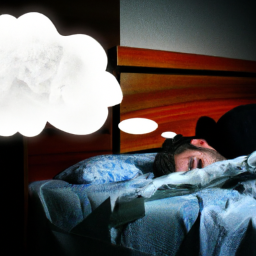Have you ever woke up from a dream wishing you could have changed what happened? Or maybe you just want to have more control and influence over your dreams. I can provide tips on how to affect and potentially even take charge of your dreams.
The world of dreaming can be both mysterious and intriguing, and for some, it can be a way to explore their subconscious mind. By learning how to influence your dreams, you can tap into your innermost desires, face your fears, and even improve your problem-solving skills.
In this article, I will share some tips and techniques that can help you take control of your dreams and make them more vivid, exciting, and meaningful. So, let’s get started!
Key Takeaways
- Keeping a dream journal is crucial to tap into the power of dreams and explore their hidden meanings.
- Setting an intention before sleep and using visualization techniques can increase the chances of becoming lucid in dreams and taking control.
- Techniques like MILD and WILD can be used to set an intention to have a lucid dream and achieve incredible dream experiences.
- Dream control can lead to a sense of empowerment and self-awareness, helping to tap into innermost desires, face fears, and improve problem-solving skills.
Keep a Dream Journal
You’ll want to start keeping a dream journal if you want to tap into the power of your dreams and explore their hidden meanings.
Writing down your dreams as soon as you wake up is crucial because our memory of dreams fades quickly. By recording your dreams, you can start to notice patterns and recurring themes, which can provide insight into your subconscious thoughts and feelings.
Not only can a dream journal help you remember and analyze your dreams, but it can also be a tool for influencing them. By setting an intention before you go to sleep and writing it down in your dream journal, you plant a seed in your mind that can manifest in your dreams.
This is just one way to take control of your dreams and use them to gain a deeper understanding of yourself. So start keeping a dream journal and get ready to unlock the secrets of your subconscious.
Practice Reality Checks
When you’re awake, it’s easy to overlook the small details of your surroundings, but by practicing reality checks, you’ll be more likely to notice them in your dreams.
Reality checks are simple exercises that help you determine whether you’re dreaming or awake. For instance, you can try pinching yourself, looking at your hands or trying to read something. The idea is to get into the habit of questioning your reality so that you’re more aware of your surroundings when you’re dreaming.
When you consistently practice reality checks, your brain will start to recognize the signs that you’re dreaming. This will make it easier for you to become lucid in your dreams and take control of them.
However, reality checks alone may not be enough to influence your dreams. That’s why it’s also important to use visualization techniques, which we’ll explore in the next section.
Use Visualization Techniques
By incorporating visualization techniques into my routine, I’ve been able to increase my chances of becoming lucid in my dreams and taking control of them.
One technique that I’ve found particularly effective is imagining myself becoming aware that I’m dreaming and then visualizing myself taking control of the dream, such as flying or exploring a new environment. This not only helps me to recognize when I’m dreaming, but it also gives me a clear goal to work towards once I become lucid.
Another visualization technique that I’ve found helpful is creating a mental checklist of things to do once I become lucid. For example, I might visualize myself reminding myself to stay calm, to stabilize the dream environment, or to experiment with different dream control techniques.
By visualizing these actions, I’m better able to remember them once I’m in the dream and increase my chances of having a successful lucid experience. With these visualization techniques, I’m able to take a step closer to achieving lucidity in my dreams.
Try Mnemonic Induction of Lucid Dreams (MILD)
I wanna share with you a technique that I’ve been trying to induce lucid dreams called Mnemonic Induction of Lucid Dreams (MILD).
It involves three key steps: setting your intention to have a lucid dream, repeating a personal mantra to yourself, and visualizing yourself becoming aware that you are dreaming.
By setting my intention before going to bed and practicing these steps, I’m hoping to increase my chances of having a lucid dream and taking control of my dream world.
Set Your Intention
You can make your dreams more meaningful by setting your intention before you go to sleep. This means you should have a clear idea of what you want to dream about and what you hope to achieve in your dream.
For example, if you want to overcome a fear or phobia, you can set the intention to confront that fear in your dream. Or, if you want to improve a skill, you can set the intention to practice that skill in your dream. Setting your intention helps your subconscious mind focus on what you want and increases the likelihood of achieving your desired outcome in your dream.
Once you have set your intention, it’s important to repeat your mantra throughout the day and before you go to bed. A mantra is a short phrase or affirmation that reminds you of your intention and helps you stay focused on it. For example, if your intention is to confront a fear, your mantra could be “I’m brave and fearless.”
The more you repeat your mantra, the more it becomes ingrained in your subconscious, and the more likely you are to have a dream that aligns with your intention. So, set your intention and repeat your mantra to increase your chances of influencing your dreams.
Repeat Your Mantra
As I lie down in bed, I begin to repeat my mantra, slowly and softly. I allow my mind to focus solely on the words and their meaning, letting go of any distractions or worries.
My mantra is my guide, my anchor, guiding my thoughts towards my desired outcome. As I continue to repeat it, I feel my mind becoming more relaxed and open to suggestion. With each repetition, my mantra becomes more ingrained in my subconscious, strengthening its power to influence my dreams.
As I drift off to sleep, I visualize my mantra as a beacon of light, leading me towards my desired dream experience. And as I enter the realm of dreams, I know that my mantra will continue to guide me towards the outcome that I desire, creating a vivid and unforgettable dream world.
Visualize Your Dream
Imagine yourself experiencing the dream of a lifetime, seeing every detail unfold before your eyes as if it were truly happening right in front of you, all while feeling completely immersed in the moment. One way to influence your dreams is to visualize them before going to sleep. This involves creating a mental image of what you want to dream about and focusing on it until you fall asleep. To make this technique more effective, you can use a visualization table that helps you create a vivid picture of your dream.
Here is an example of a visualization table that you can use:
| Column 1 | Column 2 |
|---|---|
| Setting | Characters |
| Objects | Actions |
| Emotions | Senses |
By filling out this table, you can create a detailed mental image of your dream that will increase the likelihood of experiencing it during the night. For instance, if you want to dream about a beach, you can imagine the sun setting over the horizon, the sound of waves crashing on the shore, and the feeling of sand between your toes. You can also picture yourself walking on the beach with your partner and feeling happy and content. With practice, this technique can become a powerful tool for influencing your dreams and experiencing them in a more vivid and memorable way.
Transitioning into the subsequent section, experimenting with wake-induced lucid dreams (WILD), is another way to take control of your dreams.
Experiment with Wake-Induced Lucid Dreams (WILD)
So, I’ve been experimenting with Wake-Induced Lucid Dreams (WILD) lately, and it’s been quite a journey. The key points to keep in mind are to stay awake while falling asleep, focus on hypnagogic imagery, and ultimately enter your dream world.
It’s definitely not an easy technique to master, but the potential for incredible lucid dream experiences makes it worth the effort.
Stay Awake While Falling Asleep
Stay awake while falling asleep by keeping your eyes open as you lay in bed, resisting the urge to drift off. This technique is known as the ‘Wake-Back-To-Bed’ method and it involves setting an alarm to wake up after a few hours of sleep, staying awake for about 30 minutes and then going back to sleep with the intention of having a lucid dream.
To make the most of this method, here are some tips to follow:
-
During the 30 minutes of wakefulness, avoid any stimulating activities such as checking your phone or watching TV. Instead, engage in quiet and calming activities such as reading a book or meditating.
-
Set your intention to have a lucid dream before going back to sleep. Repeat a mantra or visualize yourself becoming lucid in your dream.
-
Use the time to reflect on your past dreams and identify any recurring themes or patterns to help you recognize when you are dreaming.
-
Keep a dream journal by your bedside to record any dreams you may have, including details such as emotions, colors and symbols.
By staying awake while falling asleep, you are creating a window of opportunity to influence your dreams and potentially have a lucid dream. Focus on hypnagogic imagery as you drift off to sleep to further enhance your chances of having a memorable and lucid dream.
Focus on Hypnagogic Imagery
Focusing on hypnagogic imagery while falling asleep can enhance the chances of experiencing vivid and lucid dreams. Hypnagogic imagery is the visual and sensory experiences that occur during the transition from wakefulness to sleep. By focusing on these images and sensations, I can remain aware as I drift into sleep and increase my chances of entering a dream state.
To focus on hypnagogic imagery, I need to relax my body and mind and allow myself to become immersed in the images and sensations. I can do this by lying down in a comfortable position, closing my eyes, and observing the patterns and colors that emerge in my mind’s eye.
As I focus on these images, I can allow myself to become more and more relaxed, until I’m able to enter my dream world.
Enter Your Dream World
Once I enter my dream world, my brain can create up to five dreams per night, each lasting around 20-30 minutes. It’s a fascinating experience to be able to influence what happens in my dreams, and I’ve found that the more I practice, the more control I have over the content.
To help create a vivid picture in your mind, imagine a table with three columns and four rows. In the first column, there are different settings such as a beach, a forest, a city, and a mountain. In the second column, there are different people or creatures such as a friend, a stranger, a unicorn, and a dragon. In the third column, there are different actions such as flying, swimming, running, and dancing. By mentally selecting one item from each column, you can create a unique scenario in your dream world. For example, you could imagine yourself on a beach with a unicorn, and you’re both flying over the ocean. By focusing on this imagery before falling asleep, you’re more likely to dream about it and even have some control over what happens next.
Frequently Asked Questions
Can external factors, such as diet or sleep patterns, affect dream content?
Yes, external factors like diet and sleep patterns can affect dream content. Eating spicy food or consuming alcohol before bed can lead to more vivid or bizarre dreams, while irregular sleep patterns can disrupt the normal sleep cycle and impact dream recall.
How long does it typically take to see results from practicing lucid dreaming techniques?
It typically takes a few weeks of consistent practice to see results from lucid dreaming techniques. Keeping a dream journal, reality checks throughout the day, and setting intentions before sleep can all help enhance dream control.
Is lucid dreaming safe for everyone to try, or are there certain individuals who should avoid it?
About 55% of people report experiencing at least one lucid dream in their lifetime. While lucid dreaming is generally safe, those with certain mental health conditions may want to avoid it and consult a doctor first.
Can lucid dreaming be used as a form of therapy or self-improvement?
Lucid dreaming can be a powerful tool for therapy and self-improvement. By becoming aware and in control of our dreams, we can confront fears, practice skills, and explore our subconscious in a safe and controlled environment.
Are there any natural supplements or herbs that can help enhance dream vividness or lucidity?
Dreams can be enhanced by using natural supplements or herbs. One of my favorites is valerian root, which can increase dream vividness. Using these supplements can lead to more lucid and memorable dreams, making for a more fulfilling dream experience.
Conclusion
So there you have it, folks. If you’ve ever wanted to be the master of your own dreams, these techniques can help you achieve just that.
Keeping a dream journal, practicing reality checks, visualizing your desired dream scenarios, and experimenting with MILD and WILD techniques can all increase your chances of having lucid dreams.
Did you know that approximately half of all people have experienced at least one lucid dream in their lifetime? And of those who actively try to induce lucid dreams, up to 80% report success with these techniques.
So why not give it a try and see where your dreams can take you? Who knows, you may just discover a whole new world of possibilities within your own mind.










